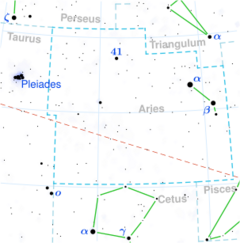Astronomy:Tau2 Arietis
| Observation data Equinox J2000.0]] (ICRS) | |
|---|---|
| Constellation | Aries |
| Right ascension | 03h 22m 45.24006s[1] |
| Declination | +20° 44′ 31.4382″[1] |
| Apparent magnitude (V) | +5.09[2] |
| Characteristics | |
| Spectral type | K3 III[3] |
| U−B color index | +1.27[2] |
| B−V color index | 1.238[4] |
| Astrometry | |
| Radial velocity (Rv) | +2.45 ± 0.24[4] km/s |
| Proper motion (μ) | RA: –51.59[1] mas/yr Dec.: –16.06[1] mas/yr |
| Parallax (π) | 10.27 ± 0.60[1] mas |
| Distance | 320 ± 20 ly (97 ± 6 pc) |
| Absolute magnitude (MV) | +0.17[5] |
| Details | |
| Radius | 19[4] R☉ |
| Luminosity | 120[4] L☉ |
| Surface gravity (log g) | 2.1[4] cgs |
| Temperature | 4,406[4] K |
| Metallicity [Fe/H] | +0.02[4] dex |
| Rotational velocity (v sin i) | 3.4[4] km/s |
| Other designations | |
τ2 Ari, 63 Arietis, BD+20 551, HD 20893, HIP 15737, HR 1015, SAO 75899.[6] | |
| Database references | |
| SIMBAD | data |
Tau2 Arietis, Latinized from τ2 Arietis, is the Bayer designation for a binary star[7] in the northern constellation on Aries. The combined apparent visual magnitude of this system is +5.09,[2] which is bright enough to be seen with the naked eye. With an annual parallax shift of 10.27 mas,[1] it is located at a distance of approximately 320 light-years (98 parsecs) from Earth, give or take a 20 light-year margin of error. At this distance the brightness of the star is diminished by 0.18 in magnitude because of extinction from interstellar gas and dust.[8]
The primary component is an evolved giant star with a stellar classification of K3 III.[9] It has expanded to 19 times the radius of the Sun, from which it is radiating 120 times the Sun's luminosity.[4] This energy is being emitted into outer space from the outer atmosphere at an effective temperature of 4,406 K,[4] giving it the cool orange glow of a K-type star. At an angular separation of 0.53 arcseconds is a magnitude 8.50 companion.[7]
References
- ↑ 1.0 1.1 1.2 1.3 1.4 1.5 van Leeuwen, F. (November 2007), "Validation of the new Hipparcos reduction", Astronomy and Astrophysics 474 (2): 653–664, doi:10.1051/0004-6361:20078357, Bibcode: 2007A&A...474..653V.
- ↑ 2.0 2.1 2.2 Argue, A. N. (1966), "UBV photometry of 550 F, G and K type stars", Monthly Notices of the Royal Astronomical Society 133 (4): 475, doi:10.1093/mnras/133.4.475, Bibcode: 1966MNRAS.133..475A.
- ↑ Cenarro, A. J. et al. (January 2007), "Medium-resolution Isaac Newton Telescope library of empirical spectra - II. The stellar atmospheric parameters", Monthly Notices of the Royal Astronomical Society 374 (2): 664–690, doi:10.1111/j.1365-2966.2006.11196.x, Bibcode: 2007MNRAS.374..664C.
- ↑ 4.0 4.1 4.2 4.3 4.4 4.5 4.6 4.7 4.8 4.9 Massarotti, Alessandro et al. (January 2008), "Rotational and Radial Velocities for a Sample of 761 HIPPARCOS Giants and the Role of Binarity", The Astronomical Journal 135 (1): 209–231, doi:10.1088/0004-6256/135/1/209, Bibcode: 2008AJ....135..209M.
- ↑ Anderson, E.; Francis, Ch. (2012), "XHIP: An extended hipparcos compilation", Astronomy Letters 38 (5): 331, doi:10.1134/S1063773712050015, Bibcode: 2012AstL...38..331A.
- ↑ "63 Ari". SIMBAD. Centre de données astronomiques de Strasbourg. http://simbad.u-strasbg.fr/simbad/sim-basic?Ident=63+Ari.
- ↑ 7.0 7.1 Eggleton, P. P.; Tokovinin, A. A. (September 2008). "A catalogue of multiplicity among bright stellar systems". Monthly Notices of the Royal Astronomical Society 389 (2): 869–879. doi:10.1111/j.1365-2966.2008.13596.x. Bibcode: 2008MNRAS.389..869E.
- ↑ Famaey, B. et al. (January 2005), "Local kinematics of K and M giants from CORAVEL/Hipparcos/Tycho-2 data. Revisiting the concept of superclusters", Astronomy and Astrophysics 430 (1): 165–186, doi:10.1051/0004-6361:20041272, Bibcode: 2005A&A...430..165F
- ↑ Roman, Nancy G. (July 1952), "The Spectra of the Bright Stars of Types F5-K5", Astrophysical Journal 116: 122, doi:10.1086/145598, Bibcode: 1952ApJ...116..122R.
External links
 |


